ColdFusion 8 Installation
UPDATE: This article has become outdated, as it discusses a previous version of ColdFusion. I've also written separate articles demonstrating how to install ColdFusion version 11 and ColdFusion version 2016.
As mentioned in the introduction, you need to install ColdFusion before you can build ColdFusion applications on your local computer.
You can download ColdFusion from the Adobe website (Adobe is the company that produces ColdFusion). Adobe has this comparison of the ColdFusion editions to ensure you download the correct edition.
Don't forget that the (free) developer edition actually gives you the same functionality as the full-blown enterprise version. The only limitation is that you can only access the website from the local computer and two other IP addresses. This means that, as long as your web hosting plan supports ColdFusion, you won't actually need to pay for ColdFusion in order to build your website.
Screen Shots of Installation
To give you an idea of what ColdFusion installation involves, below are the steps that I took when installing ColdFusion 8 Developer edition onto a machine running Windows XP.
This page was created when ColdFusion 8 was the current version. If you have a later version of ColdFusion, the steps may differ slightly from below.
Initial Screen: Confirm Language
Once you've downloaded ColdFusion, double click on the icon. This should launch the following window. Click "OK" to confirm that the language is correct. If it's not correct, either select the correct language (if you can) or head back to the Adobe website and download the correct file.
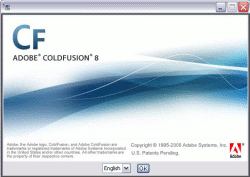
Step 1: Introduction
Once you've confirmed the language, the ColdFusion installation process begins. As you can see from the following screen shot, this is a 7 step process (although, it may be more, depending on the options that you select).
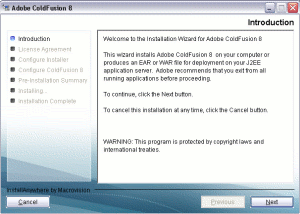
Step 2: Licence Agreement
Confirm that you've read and agree to the licence agreement:
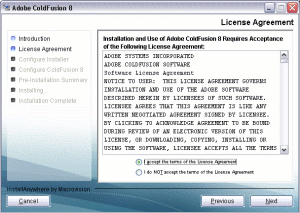
Step 3: Install Type
Select the installation type.
In most cases, selecting "Developer Edition" is fine. Only select "30 Day Trial" if you need to be able to access your website from more than 2 external IP addresses (in addition to the website's local computer). Once the 30 days is up, ColdFusion will revert to the Developer edition (unless you pay for the Standard or Enterprise version).
Of course, if you have purchased a copy of ColdFusion, enter your serial number at this screen.
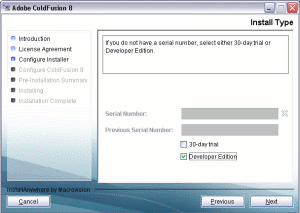
Step 4: Installer Configuration
Select an installer option.
The first option ("Server Configuration") is the most common option. The other options are useful for running multiple instances of ColdFusion on your computer. If you choose the second or third option, you should refer to the ColdFusion documentation.
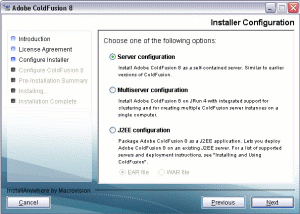
Step 5: Subcomponent Installation
Select the subcomponents you want to install. By default, all subcomponents are selected.
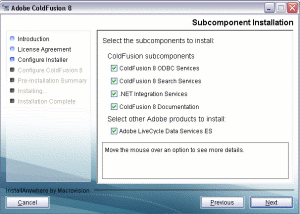
Step 6: Select Installation Directory
Select the directory you'd like to install Coldfusion into:
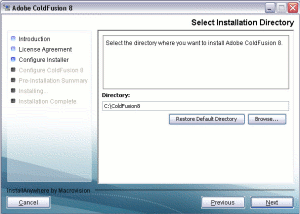
Step 7: Licence Agreement (for Adobe LifeCycle Data Services ES)
This screen only appears if you previously selected Adobe LifeCycle Data Services ES (at step 5):
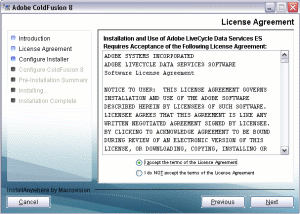
Step 8: Adobe LifeCycle Data Services ES Installation
This screen only appears if you previously selected Adobe LifeCycle Data Services ES (at step 5). If you have a serial number for Adobe LifeCycle Data Services ES, enter it here. Otherwise leave it blank:
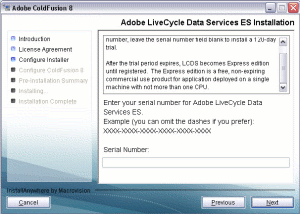
Step 9: Previous ColdFusion Installation Detected
This screen may be different, depending on whether your computer has a previous version of ColdFusion installed. If you do, you can choose to have both versions co-exist on your computer, or to overwrite the previous version. In this example, I chose to configure my web server (IIS) to use the new version. Doing this overwrites the previous version:
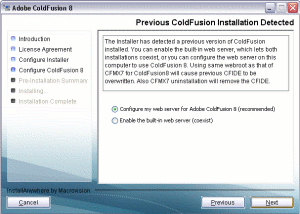
Step 10: Configure Web Servers/Websites
If you run your own web server (such as IIS or Apache), this screen allows you to select which websites should be configured to use ColdFusion:
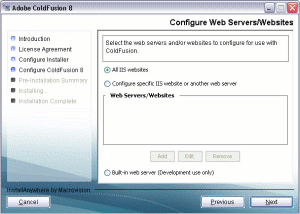
Step 11: Choose ColdFusion Administrator Location
This screen lets you choose where to put the files for the ColdFusion Administrator. The CF Administrator is usually accessed via /cfide/administrator:
I sometimes like to keep these files separate to the rest of the website. Therefore, I use a separate location at this screen. I then create a virtual directory (from my web server ) and map it to this directory. Creating the virtual director allows me to access the ColdFusion Administrator from http://{webroot}/cfide/administrator".
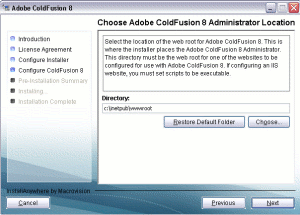
Step 12: Administrator Password
You are required to enter a password which is used for accessing the ColdFusion Administrator:
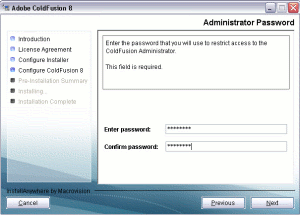
Step 13: Enable RDS
You have the option of enabling RDS (Remote Development Service). Only enable RDS if you need to access the server remotely for development purposes. As a general rule, you should disable RDS on production servers (for security reasons).
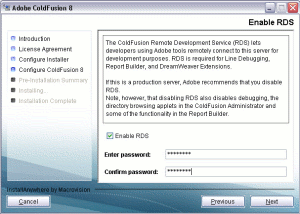
Step 14: Pre-Installation Summary
Review your settings. You can go back and change anything that's incorrect. If all is correct, click "Install". This is the bit that actually installs ColdFusion on your computer.
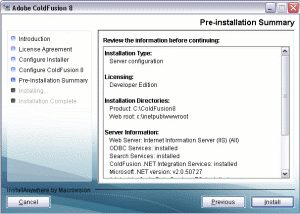
Step 15: Installation Complete
Once ColdFusion has been installed, you will see the following screen. You will be notified of any errors that occurred during installation with instructions on how to view the log file.
It could take around 5 to 10 minutes for installation to complete, and for this screen to appear.
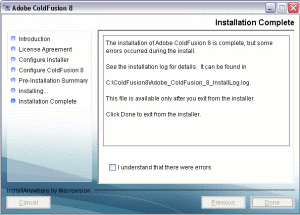
ColdFusion Migration
Once ColdFusion has been installed, open the ColdFusion Administrator at http://{websiteroot}/cfide/administrator (where {websiteroot} is the URL of your website).
If your ColdFusion installation was upgraded from a previous ColdFusion installation, you will be prompted through a migration wizard. This will automatically migrate your previous ColdFusion settings to your new installation.
Here are some screen shots of the ColdFusion Migration Wizard.